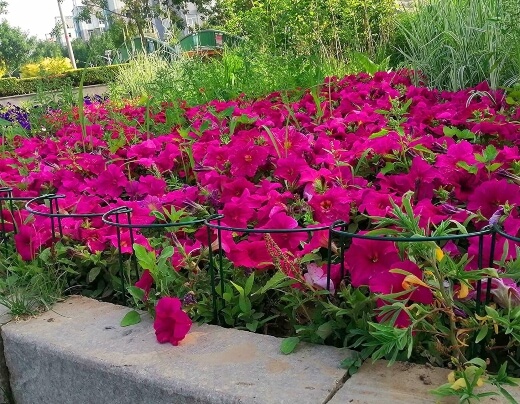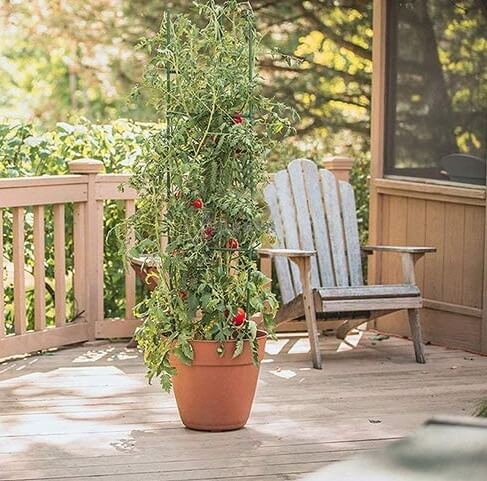Though staking is a common activity for many growers, there is certainly a way to do it right depending on the tree or plant that needs stabilisation. Staking plants or staking a tree incorrectly can impede the growth and mechanical stability of the plant instead of assisting it as intended.
Environmental factors in your area can also play a role when staking plants so knowing how and when to stake correctly is a good tool for any green thumb to have. Here is how you can use garden staking in your landscape.
More...
Getting to Know Tree Staking
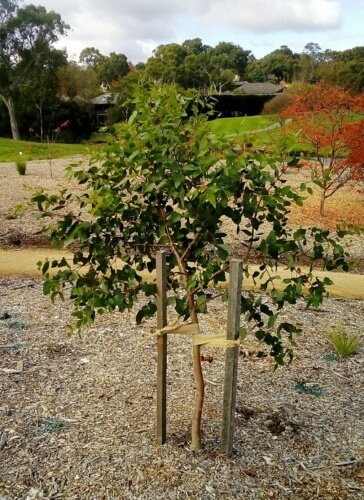
Staking is necessary for any newly planted large tree. Staking can also be necessary for smaller trees and shrubs, depending on the individual plant and the environmental conditions present at the site itself.
For example, if your site is either at high altitude or along the coast, shrubs and small trees that may not require staking in calmer environments, can often benefit from staking.
Soil type can also impact whether or not you’ll need to stake your particular plant. A deep clayey soil will provide the root-ball with a greater degree of support than will a loosely consolidated sandy or gravelly soil.
So first up, undertake a site assessment to ascertain whether you need to stake your plant or not.
Key Reasons Why We Stake Plants
Whether you’re staking tomato plants, a prize-winning dahlia or a recently bought sapling there are some guidelines that will help you support your plants the most effectively. The reason we stake our plants are multifaceted but here are the two key reasons;
- Support: a well-positioned stake can offer a plant strength against harsh winds, heavily fruiting branches or even some assistance until the plant’s stem is strong enough to support its own weight.
- Training: gardeners often like to stake plants in order to train them to grow certain ways. Multiple-trunked trees are often the benefactors of such staking, forcing the stems to grow in predetermined directions that naturally they wouldn’t achieve.
While there may only be a couple of reasons for using plant stakes there are certainly a ton of different materials that you can use;
- Bamboo
- Rough-dressed garden stakes
- Star-Pickets
- Kopper logs
- Bush poles or Dried straight branches
- Steel reinforcing “Reo” bars
- PVC tubing
… just to name a few.
Considerations When Staking Plants
The main purpose of using plant stakes is to offer support to the plant. There are a few considerations that need to be taken into account such as; (1) the growth rate of the plant, (2) the time that the plant will require staking, and (3) the extreme conditions that the plant must weather as it begins to grow.
- Plant’s Growth Rate – this is an important factor for it will determine the size of the stakes needed. The last thing you want to be doing with your plants is re-staking them every few months because the plant has out-grown their effectiveness.
Consider how large your plant should be in the next 12 months – 2 years and size the stakes accordingly. - Time Required for Staking – this factor will determine the material required to stake your plant. If you have a slow-growing specimen that may need 5-10 years before the stakes can be removed, it pays to consider materials that will last this time period.
Obviously, those plants that only require a short period of time can safely be staked with more lightweight, and usually less expensive, materials. A slow-growing tree may require star-pickets or kopper logs while staking tomato plants can be achieved with some nimble bamboo sticks or garden stakes. - Weather or Growing Conditions – the prevailing conditions the plant will have to face in its attempt to grow on your property will determine the number of plant stakes required.
If your location doesn’t suffer from constant strong winds then 1-2 stakes may be all that is needed while areas that are regularly battered by prevailing gusts should opt for up to 3 stakes to protect and support their plants.
Materials Needed for Tree Staking
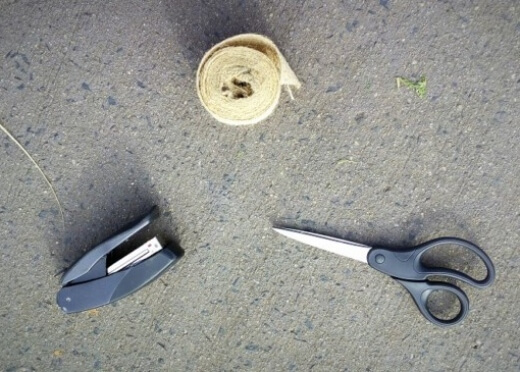
Equipment needed to secure your tree to your stake:
- a hessian tie
- a buckle tie and spacer, or an old stocking
- a stapler (only if you’re using a hessian tie in which case you can use staples to bolster the knot)
- scissors to cut the fabric.
- Wood commonly used for staking includes bamboo (useful for smaller trees and plants), and hardwood stakes.
Methods on How to Stake a Tree
There are several different methods for staking trees. How you stake your shrub or tree depends on the type of plant, its size, and its planting method. Wood commonly used for staking includes bamboo (useful for smaller trees and plants), and hardwood stakes.
For medium to large-sized trees, hardwood stakes are advised.
- For trees, which I will concentrate on here, I tend to ensure the stakes penetrate the soil to at least 60cm in depth.
- The deeper the stake, the less likely it is to fall over, taking the plant with it.
- Once you’ve hammered in your stake, secure your tree using the Figure-8 technique (shown below).
- This will ensure there is enough slack so it can gently swing in the breeze, which encourages your tree to produce important structural tissue.
Tree Staking Using a Single Stake
Single stakes are often used for bare-root trees. Bare-root trees are trees dug out from the ground when they are dormant (leafless). In this case, insert the stake before planting, because there is no existing root ball to damage, as in container-grown trees.


Get Your Free Guide:
Master Growing Australian Natives eBook
A Must Have Complete Guide for Every Australian Garden
Get Your Free Guide:
Master Growing Australian Natives eBook
A Must Have Complete Guide for Every Australian Garden
For most trees, the stake should be roughly one-third of the height of the tree. This safeguards the roots of the tree whilst allowing the stem to move with the wind, encouraging it to strengthen and thicken.
For trees with long dextrous stems, use a longer stake for increased support. Ensure there is a gap of 3cm-4cm between the stem and the stake.
If the stake is too close to the stem, it can impede growth and potentially disfigure your tree. Secure the tree to the stake using hessian ties, a buckle tie and spacer, or an old stocking.
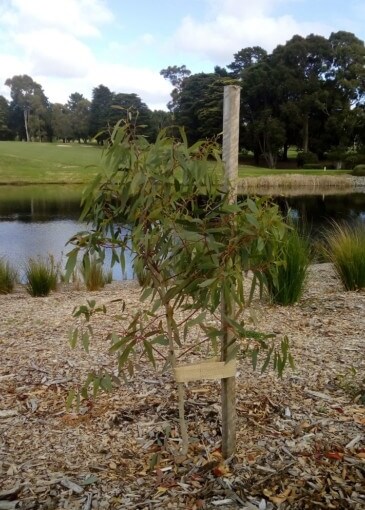
Eucalyptus leucoxylon ssp. megalocarpa (Yellow Gum) staked using the single stake method.
Here I have used a hessian tie, you can also use a buckle tie and spacer, or a piece of old stocking. The single stake method is perfect for smaller trees and shrubs.
Tree Staking Using Multi Stakes
This is commonly used for container-grown trees and trees with significant root balls. In this case, two or three stakes can be inserted into the ground opposite each other (two stakes) or equally spaced around the tree (three stakes).
- 2 Stakes: strike these two vertically into the ground at opposing sides of the plant and fasten using similar tie materials as above and apply using the Figure-8 loop.
- 3 Stakes: using three stakes gives the plant the most protection but can be overkill for some. Use this method for plants that will require a long period of staking. Locate these in a triangular form around the outside of the plant’s location and tie off. This is the best method for keeping a plant or tree growing perpendicular.
Staking an Established Plant
The problem that you will face trying to stake an established plant is trying to miss any roots as you strike the stake into the ground. Failure to do so may eventually kill your plant, or certainly injure it in any case.
If your plant needs staking after it has been established for some time, then try and locate the stakes as far away from the stem as possible. It may even pay to try and uncover some of the roots to see where the main ones are located and steer clear of them.
Once your plant stakes are in position you can tie them off as mentioned above.
In both cases, ensure that the stakes are emplaced outside the root ball. This is because penetrating the already established root ball may inflict damage on the root system, leading to growth and/or stability problems in years to come.
Secure the trunk of the tree using hessian ties, a buckle tie and spacer, or an old stocking.

Eucalyptus leucoxylon ‘Rosea’ (Red Flowering Yellow Gum) staked using hessian ties in the Figure-8 configuration.
Other Staking Tree Methods
Angled Staking
Angled stakes are less common than single stakes or multiple stakes, but if you’re planning to plant your tree on a steep gradient, an angled stake may be a good option for you.
In this case, drive the stake into the ground at a 45° angle away from the tree, leaning into the prevailing wind. Ensure you use a flexible tie to wrap around the stem – a hessian tie or an old stocking are suitable.
Best for staking trees in windy areas. This method is particularly useful for sites that both slope and are exposed to windy conditions – such as in coastal dune sands.
Guying Anchors
Guying (using guy ropes to anchor the tree) is mostly used for large transplanted trees. Guying involves driving three small wooden stakes into the ground on three sides of the tree, attaching rope or wires to these stakes, and then connecting them to the tree using a broad and smooth material, such as hessian or buckle ties.
The distance of the stakes from the tree should be proportional to the height of the tree, with the attachment of the wires or ropes to the material being made one-third or two-thirds up the stem.
How to Train with Plant Stakes
The idea of training is similar to supporting a plant although in this case you are trying to direct future growth instead of just keeping the plant supported. The main difference in supporting plants via staking versus training is that training plants, especially trees, doesn’t always require the stakes to have one end located in the ground.
Often training a tree with stakes can be attempted utilising stakes that push branches apart or hold them close together. In this process, the plant stakes will require some form of cushioning between the stake and the plant so that they don’t lance, or inflict injury upon, the plant’s outer layer.
Common Problems When Staking Trees
As mentioned in the opening paragraph, incorrect staking of trees is a common, yet avoidable, problem. Storms, however, are unavoidable and can result in stakes being damaged or broken, and your ties becoming either too tight or too loose or falling off altogether.
So, if you’ve just experienced a large storm, head outside and check up on your staked trees to ensure the ties are not causing the problems they are meant to be preventing.
In general, you should check up on your stakes and ties every once in a while, just to ensure that the ties are not rubbing up against your trees, or that your ties are not constricting the growth of the stem.
Fast-growing varieties such as Wattles (Acacia) and many Gums (Eucalyptus trees) may require more frequent attention.
If hessian ties are proving too coarse for your tree, which can be the case when staking more delicate species, you can always use a buckle tie and spacer, a recycled piece of fabric, or an old stocking.
Garden Staking
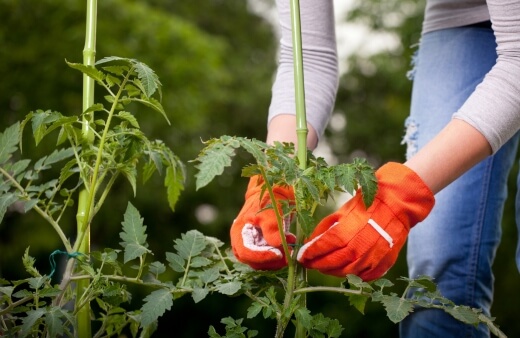
Staking plants may also be necessary for your garden or home. Some plants grow upright and will need assistance to withstand harsh environmental conditions like wind and rain whereas others may need to be staked to help them support their weight.
Top-heavy plants in your landscape will benefit from garden staking which can provide the sturdy support the plants need to thrive and keep growing.
When to Stake in the Garden
Garden staking plants should be done for any taller growing, top-heavy plants in your garden that can’t support their weight easily. By driving upright stakes into the ground and fastening your plants to them using ties, you can provide foundational strength and support to the plants and permit them to continue pushing skyward when they would otherwise be overcome by harsh weather or the weight of their fruits or flowers.
Garden staking will also focus your plants on a more upright growth habit rather than a sprawling, wider growing habit.
Types of Plants that Need to be Staked
Many different plants can benefit from garden staking when they are young or even throughout their lifespan. Here are the most common plants that need to be staked in gardens and homes.
Flowering Perennials
Perennials may need some help during their growing seasons. Plants like Dahlias, Delphiniums, Peonies and lilies can all benefit from some support as they grow.
You should prune these plants back during periods when they aren’t growing and then by attaching them to single stakes or trellises in early spring, you can help these plants grow to be fuller and denser at the height of the growing season.
Top-Heavy Houseplants
Certain indoor plants like philodendron, pothos or young fig trees can benefit from bamboo stakes that can help guide their growth and support the stems when carrying larger leaves.
When growing these houseplants in containers you can simulate the support these plants get when they grow in their natural habitats by using stakes. Garden staking for houseplants is an excellent way to ensure your plants live long and healthy lives as potted plants.
Here are our growing guides for some of these popular houseplants:
- Philodendron ‘Pink Princess’
- Philodendron ‘Brasil’
- Philodendron xanadu
- Fiddle Leaf Fig
- Best Indoor Plants in Australia
Vegetables
Many vegetables need the extra support that staking provides. Certain vegetables like tomato plants or bell pepper plants produce abundant harvests that can add a lot of extra weight to the support structure of the plant where the plants will eventually not be able to handle their weight.
Staking these plants every growing season will allow you to provide needed support from all sides and will help ensure longevity in the plants. For denser growers, you can also use tomato cages or trellises that will provide the same useful benefits.
Saplings
Flowers and vegetables aren’t the only plants that will need garden staking. Young trees will greatly benefit from stakes especially if you experience strong winds or rain in your region.
You can attach a sapling to a single stake or you could set up a multi-stake structure on either side of your young tree. Correctly fastening the sapling to the stakes using twine or bungee cords will ensure the roots have time and support to establish themselves in your landscape which will ensure your tree will grow to be strong and capable.
Common Methods for Garden Staking
When staking plants in the garden, there are four primary ways to go about this depending on the kind of support your plants need.
Single/Multi-Stake
- This is the most common plant-staking method involving the use of a single stake or multiple stakes around the plant.
- Most garden centres will stock wooden stakes, bamboo stakes, plastic stakes and metal stakes as well as many different kinds of ties.
- Hammer your stakes about 15 centimetres into the ground right next to the desired plant. Try to avoid damaging any roots if possible.
- Pick a spot about two-thirds of the way up the plant and fasten the plant to the stakes using garden ties or another suitable alternative. Be sure that your tie is not too loose and not too tight around the plant.
- Some plants may need more support than a single stake can offer. In these cases, you can stake plants to multiple supports like with the tree staking.
Ringed Grid Support
- You can use a metal ring to support plants that produce multiple, spreading stems.
- These supports feature a circular wire grid held up by metal stakes that allow stems to grow through them, guiding the growth correctly.
- The plant shoots will grow through the wire grid allowing them to fill out with foliage and fruit while being supported.
- Be sure to use this method only if needed as removing the grid at a later stage will damage the plant.
Support Cages
- Tomato cages or other support cages can work great for small trees and vegetables where the cage will provide 360 degrees of support.
- These growing cages are similar to the ringed grids but are often taller with open tops.
Trellises
- Trellises are best used on plants that spread horizontally while growing upward.
- A trellis can guide these plants by providing a stable structure for them to grow against.
- Trellises work very well as support for plants like pole beans, melons and zucchini.
See our list of the best garden trellis ideas and kits whether you'd like to buy a ready made trellis or make your own.
Garden Staking Frequently Asked Questions
What can I use for garden stakes?
Any long and straight object made from metal, plastic or wood can work as a DIY garden stake. Household items such as pool cues, broom handles and even an old golf club can be used effectively.
Alternatively, many garden centres and online stores will sell a variety of tools needed for garden staking.
What does staking mean in plants?
Staking plants can help your trees, flowers and vegetables grow best by providing them with support and protection. Stakes can also help guide your plants to grow in the right direction as well as support them during their growing seasons.
What plants need stakes?
Must-stake vegetable plants include peas, blackberries, cucumbers, pole beans, tomatoes, melons, gourds, peppers and pumpkins. Some tall perennial flowers may also need staking.
If you’re interested in also learning more about how to garden with rocks in your landscape, be sure to check out our new helpful guide below:
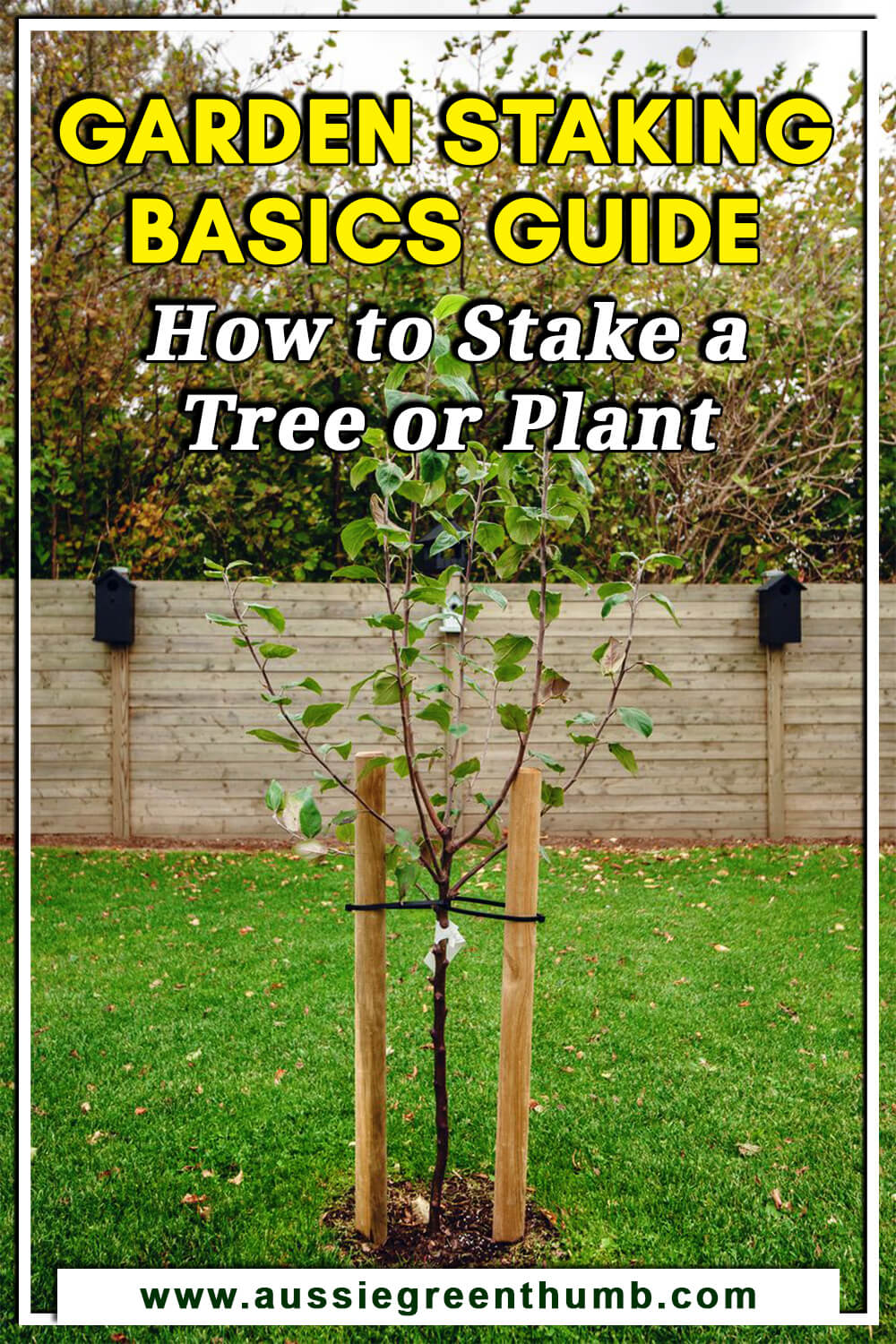
Enhance your Garden with Proper Garden Staking
Garden staking is an excellent way to support and condition your garden for optimal growth and lusciousness. Propping up your trees and plants that need a little more support and guidance will allow you to reap the most out of your garden’s greenery, especially for those plants with top-heavy foliage, flowers or fruit.
Whether it’s trees or plants, garden staking will allow you to go into your growing seasons with a little more confidence and know-how.
Published on April 12, 2022 by Clinton Anderson
Last Updated on September 20, 2024


